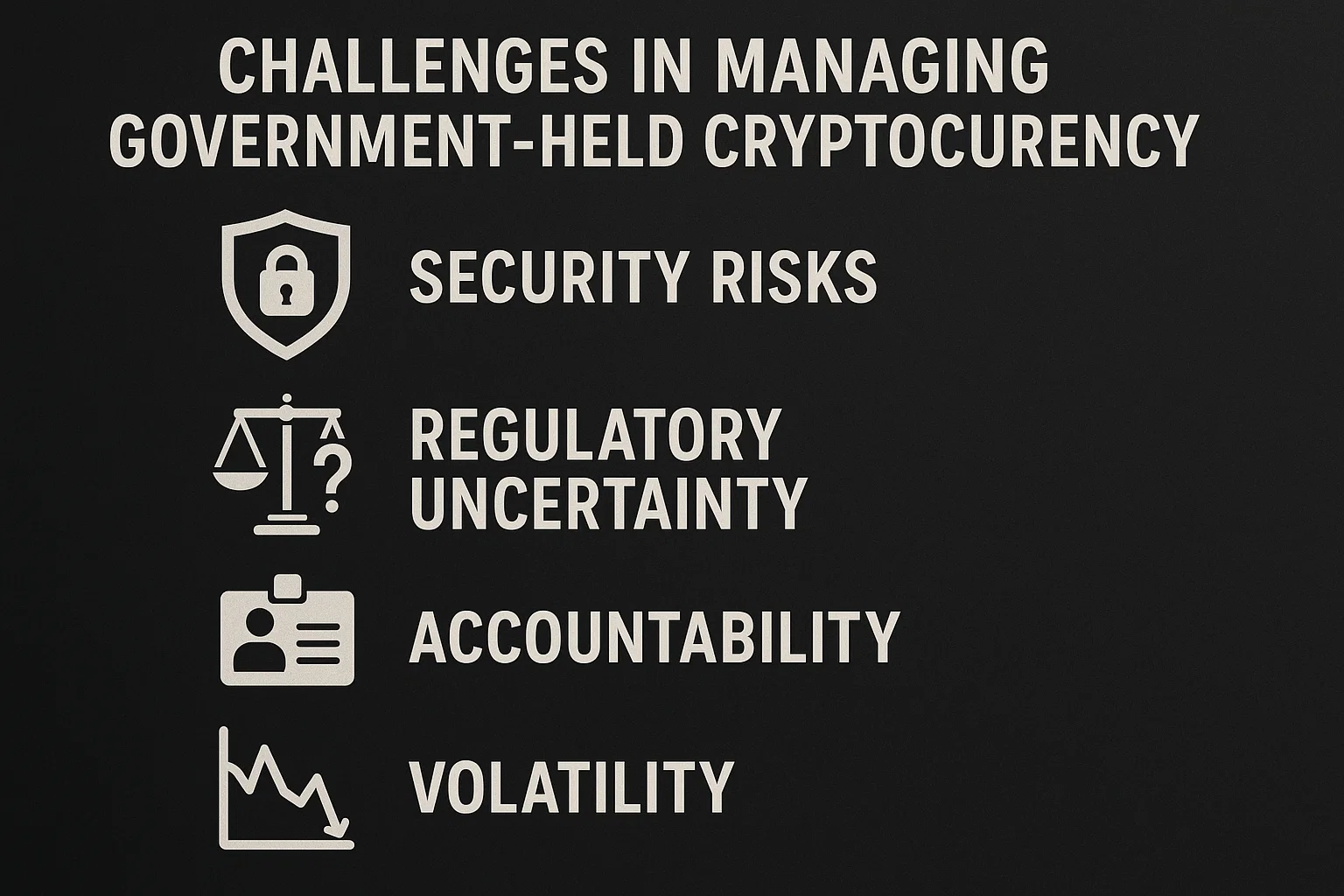The unprecedented Bitcoin seizure in the US crypto reserve case has thrust the United States government into uncharted territory. When federal authorities confiscated approximately $15 billion worth of Bitcoin in one of the largest cryptocurrency seizures in history, it didn’t just make headlines—it exposed fundamental challenges in how the government manages digital assets. This massive Bitcoin seizure raises critical questions about the feasibility of establishing a national cryptocurrency reserve, the technical infrastructure needed to secure these assets, and the policy framework required to manage volatile digital currencies. As lawmakers debate the creation of a strategic crypto reserve, this case serves as a stark reminder that US crypto reserve ambitions face significant operational, legal, and technological hurdles that must be addressed before such a strategy can succeed.
$15 Billion Bitcoin Seizure Case
Background of the Massive Cryptocurrency Confiscation
The Bitcoin seizure that captured global attention originated from a multi-year investigation into one of the most significant financial crimes in cryptocurrency history. Federal law enforcement agencies, including the FBI and IRS Criminal Investigation Division, traced thousands of Bitcoins through complex blockchain networks to identify and ultimately seize the digital assets. This particular Bitcoin seizure US crypto reserve case involved cryptocurrencies stolen from the Bitfinex exchange hack in 2016, representing one of the most significant asset recoveries in digital currency history.
The scale of this seizure is staggering. At the time of confiscation, the Bitcoin holdings were valued at approximately $3.6 billion, but as cryptocurrency markets fluctuated, the value soared to over $15 billion. This dramatic appreciation highlights one of the primary challenges facing any US crypto reserve strategy: extreme price volatility. Unlike traditional reserve assets such as gold or foreign currencies, Bitcoin can experience double-digit percentage swings in value within days or even hours.
The Technical Complexity of Seizing Digital Assets
Executing a Bitcoin seizure requires sophisticated technical expertise that goes far beyond traditional asset forfeiture. Law enforcement must navigate the complexities of blockchain technology, private key management, and cryptocurrency wallet security. In this case, investigators spent years developing the technical capabilities to trace transactions across multiple wallets and exchanges, utilizing blockchain analytics tools and working with cryptocurrency experts.
The implications of the US crypto reserve become evident when considering the infrastructure needed to secure seized assets. Government agencies must maintain “cold storage” wallets—offline devices that hold private keys—with military-grade security protocols. A single compromised private key could result in the irreversible loss of billions of dollars in cryptocurrency. This technical challenge represents a significant barrier to establishing a functional national crypto reserve.
Challenges in Managing Government-Held Cryptocurrency
Security Vulnerabilities and Custody Solutions
The Bitcoin seizure US crypto reserve case exposes critical security vulnerabilities in government cryptocurrency custody. Unlike physical assets stored in Fort Knox, Bitcoin exists as cryptographic keys that hackers can steal from anywhere in the world. Government agencies, traditionally focused on physical asset security, must now protect against sophisticated cyber threats from nation-state actors, organized crime syndicates, and individual hackers.
Current government custody solutions remain inadequate for managing a strategic crypto reserve. The US Marshals Service, which handles seized assets, has historically auctioned Bitcoin holdings quickly to avoid the burden of long-term storage and market risk. However, a national US crypto reserve strategy would require indefinite holding periods, necessitating institutional-grade custody solutions with redundant security measures, multi-signature wallets, and comprehensive insurance coverage.
Valuation and Accounting Difficulties
Accounting for seized Bitcoin presents unprecedented challenges for government financial management. Traditional Generally Accepted Accounting Principles (GAAP) struggle to accommodate the unique characteristics of cryptocurrency. How should the Treasury value Bitcoin holdings—at seizure price, current market value, or some other metric? The $15 billion Bitcoin seizure illustrates this problem: the value of the assets has fluctuated by billions of dollars since confiscation.
For a strategic US crypto reserve, these valuation questions become even more complex. Reserve assets typically serve as stable stores of value that backstop national currency and economic policy. Bitcoin’s notorious volatility contradicts this fundamental purpose. Financial statements for government crypto holdings would require constant revaluation, potentially creating artificial budget surpluses or deficits based solely on market movements rather than actual fiscal performance.
Legal and Regulatory Framework Gaps
Asset Forfeiture Laws and Cryptocurrency
Existing asset forfeiture laws were designed for tangible property and traditional financial instruments, creating legal gray areas for Bitcoin seizure cases. Courts must determine whether cryptocurrency constitutes currency, property, commodities, or securities—a classification question with profound implications for how these assets can be seized, held, and eventually disposed of.
The discussion about the Bitcoin seizure and the US crypto reserve reveals gaps in regulatory authority. Which agency should manage a national crypto reserve? The Treasury Department, Federal Reserve, or a newly created digital asset authority? Current jurisdictional ambiguities between the SEC, CFTC, FinCEN, and other regulators create confusion that would complicate any coordinated US crypto reserve strategy.
Due Process and Property Rights Concerns
Cryptocurrency seizures raise unique due process concerns. The pseudonymous nature of blockchain transactions means that innocent parties’ assets might be swept up in broad seizures targeting criminal enterprises. The irreversible nature of Bitcoin transactions means that if the government mistakenly transfers seized crypto, recovery becomes virtually impossible.
Establishing a US crypto reserve from seized assets could face constitutional challenges. Property rights advocates argue that forcing the conversion of seized Bitcoin into a government reserve, instead of returning it to victims or auctioning it publicly, could constitute an unconstitutional taking. These legal questions remain largely unresolved, creating uncertainty around any long-term government cryptocurrency holding strategy.
Economic and Market Impact Considerations
Market Manipulation Risks
Government management of extensive Bitcoin holdings creates potential market manipulation risks that complicate US crypto reserve planning. The $15 billion Bitcoin seizure represents a significant percentage of daily trading volume. If the government were to liquidate these holdings suddenly, it could crash cryptocurrency markets, harming innocent investors and potentially destabilizing the broader digital asset ecosystem.
Conversely, an announced US crypto reserve strategy could artificially inflate Bitcoin prices as markets anticipate government buying or holding. This creates moral hazard problems: criminal enterprises might intentionally use Bitcoin, knowing that seizures contribute to a government stockpile that supports prices. The economic distortions created by government crypto market participation could undermine the decentralized principles that make blockchain technology valuable.
Opportunity Costs and Fiscal Policy
Holding a Bitcoin seizure of the US crypto reserve involves significant opportunity costs. The $15 billion in seized cryptocurrency could alternatively fund public infrastructure, debt reduction, or other government priorities. Financial advisors question whether allocating public funds (through foregone asset sales) to volatile crypto assets represents prudent fiscal management.
From a monetary policy perspective, a US crypto reserve could complicate Federal Reserve operations. If the government holds substantial Bitcoin positions, its value fluctuations could affect federal balance sheets and potentially constrain policy options during economic crises. Traditional reserve assets like gold and foreign currency serve as stability mechanisms; cryptocurrency’s volatility could have the opposite effect.
Technical Infrastructure Requirements
Building Institutional-Grade Custody Systems
Creating a functional US crypto reserve requires infrastructure that doesn’t currently exist in government. The Bitcoin seizure case demonstrates that law enforcement can successfully confiscate crypto assets, but long-term custody demands different capabilities. Institutional custody solutions must incorporate:
- Multi-signature wallet architectures require multiple authorized parties to approve transactions
- Hardware security modules (HSMs) certified to government standards
- Redundant backup systems across geographically distributed locations
- Comprehensive key management protocols with succession planning
- Real-time monitoring and incident response capabilities
Private sector cryptocurrency custodians charge substantial fees for these services—costs that would scale significantly for a multi-billion dollar crypto reserve. The government would need to either develop internal capabilities, which requires recruiting scarce blockchain expertise, or outsource to private vendors, raising security and oversight concerns.
Blockchain Analytics and Compliance Tools
Managing seized Bitcoin and maintaining a US crypto reserve requires sophisticated blockchain analytics capabilities. Government agencies must be able to:
- Trace cryptocurrency transactions across complex mixing services and privacy coins
- Monitor crypto holdings for suspicious activity or attempted thefts
- Ensure compliance with anti-money laundering (AML) and know-your-customer (KYC) regulations
- Coordinate with international law enforcement on cross-border crypto investigations
The Bitcoin seizure US crypto reserve case involved years of blockchain forensic work. Scaling this capability to manage an ongoing strategic reserve would require substantial investment in technology, training, and personnel—costs that must be weighed against the benefits of holding cryptocurrency assets.
Policy Alternatives and Strategic Options
Rapid Liquidation vs. Long-Term Holding
The traditional approach to seized assets—rapid auction and liquidation—minimizes government exposure to Bitcoin volatility and custody risks. The US Marshals Service has historically auctioned cryptocurrency holdings shortly after legal proceedings conclude. This approach realizes immediate value, avoids market timing risks, and reduces security burdens.
However, advocates for a US crypto reserve strategy argue that immediate liquidation sacrifices potential appreciation. The $15 billion Bitcoin seizure was worth a fraction of its current value when initially confiscated. Proponents suggest that holding crypto assets could provide significant returns and position the United States as a leader in digital asset policy.
The middle path involves structured disposition strategies that gradually liquidate holdings over time, similar to how governments manage strategic petroleum reserves. This approach could balance the benefits of cryptocurrency exposure with prudent risk management, though it requires developing the technical infrastructure and policy frameworks discussed earlier.
Public-Private Partnership Models
Rather than managing Bitcoin holdings directly, the government could explore public-private partnership models for a US crypto reserve. Regulated custodians with proven security records could hold seized cryptocurrency on behalf of the Treasury, combining private sector expertise with public oversight.
These partnerships could address many technical challenges while maintaining government control over strategic decisions. However, they introduce counterparty risks—the custodian’s failure could jeopardize billions in public assets. The Bitcoin seizure case highlights that even sophisticated cryptocurrency firms face hacking risks, as evidenced by the original Bitfinex breach that led to the theft.
International Precedents and Comparative Analysis
How Other Nations Handle Seized Cryptocurrency
The Bitcoin seizure of the US crypto reserve challenge isn’t unique to the United States. Several nations have confronted similar questions with varying approaches:
Germany has held seized Bitcoin for extended periods, benefiting from price appreciation but also experiencing the volatility risks. Bulgaria reportedly holds substantial crypto reserves from seizures, though the lack of transparency makes assessment difficult.
El Salvador took the unprecedented step of adopting Bitcoin as legal tender and building a national crypto reserve through purchases rather than seizures. This experiment has faced significant challenges, including IMF concerns about fiscal stability and implementation difficulties.
These international precedents suggest that US crypto reserve planning can learn from others’ experiences, both successes and failures. However, the scale of American cryptocurrency markets and the volume of potential Bitcoin seizures create unique challenges that foreign models may not adequately address.
Regulatory Frameworks in Leading Crypto Jurisdictions
Progressive cryptocurrency regulations in jurisdictions like Switzerland, Singapore, and the United Arab Emirates offer models for legal frameworks that could support a US crypto reserve. These countries have developed clear regulatory classifications, robust custody standards, and government coordination mechanisms.
The Bitcoin seizure US crypto reserve debate could benefit from studying how these jurisdictions balance innovation with risk management. However, their approaches reflect different governmental structures, financial systems, and policy priorities that may not directly translate to the American context.
Future Implications for Cryptocurrency Policy
The Path Forward for Digital Asset Management
The $15 billion Bitcoin seizure serves as a wake-up call for policymakers. Whether or not the United States pursues a strategic crypto reserve, the government will continue seizing digital assets in criminal investigations. Developing competent management capabilities isn’t optional—it’s necessary for effective law enforcement and asset recovery.
Forward-looking policy should address:
- Clear custody standards for government-held cryptocurrency
- Transparent valuation and accounting methodologies
- Coordinated regulatory authority over digital assets
- Technical training programs for law enforcement and financial agencies
- International cooperation frameworks for cross-border crypto cases
These foundational elements would enable more sophisticated policy discussions about strategic crypto holding strategies, including potential US crypto reserve options.
Balancing Innovation with Risk Management
The Bitcoin seizure US crypto reserve conversation reflects broader tensions in cryptocurrency policy. Innovation advocates argue that government crypto holdings legitimize digital assets and position America for technological leadership. Risk-averse policymakers counter that the government shouldn’t speculate in volatile assets or lend credibility to cryptocurrencies with limited regulatory oversight.
Effective policy must balance these perspectives. Cryptocurrency and blockchain technology offer genuine innovations with transformative potential for finance, supply chains, and digital identity. However, hype and speculation have created bubble dynamics that pose risks to investors and financial stability.
A prudent approach might involve pilot programs that test crypto reserve concepts on limited scales, allowing policymakers to assess practical challenges before committing to comprehensive strategies. The $15 billion Bitcoin seizure provides an ideal test case—these assets exist regardless of policy decisions, offering an opportunity to develop expertise without additional taxpayer risk.
Expert Perspectives and Industry Reactions
Financial Sector Views on Government Crypto Holdings
Traditional financial institutions have expressed skepticism about US crypto reserve proposals. Banking executives question whether cryptocurrency meets the fundamental criteria for reserve assets: stability, liquidity, and broad acceptance. The Bitcoin seizure volatility illustrates these concerns—reserve assets shouldn’t fluctuate 30% in value over weeks.
Conversely, cryptocurrency industry leaders enthusiastically support government crypto holdings. They argue that official reserves would legitimize digital assets, increase institutional adoption, and potentially stabilize markets through government participation. However, critics note that industry support may be self-interested, as government buying would increase demand for their holdings.
Academic economists generally remain skeptical, noting that Bitcoin’s limited intrinsic value and speculative nature make it unsuitable as a reserve asset. The Bitcoin seizure in the US crypto reserve case doesn’t change the fundamental economic properties that distinguish cryptocurrency from traditional reserves like gold or foreign currency.
Blockchain Technology Advocates’ Recommendations
Blockchain technology advocates distinguish between supporting cryptocurrency adoption and endorsing specific crypto reserve strategies. Many technologists argue that the government should focus on developing blockchain infrastructure services, such as digital identity, verification, and certification, voting systems, rather than speculating in Bitcoin markets.
These experts suggest that the $15 billion Bitcoin seizure should prompt investment in blockchain literacy and technical capabilities across government agencies. Whether or not authorities maintain a crypto reserve, they’ll need blockchain expertise for regulatory enforcement, criminal investigation, and assessing emerging technologies.
Risk Assessment and Mitigation Strategies
Cybersecurity Threats to Government Crypto Holdings
A US crypto reserve would become an immediate target for sophisticated cyber adversaries. Nation-state hackers, organized crime groups, and individual cybercriminals would focus enormous resources on compromising government cryptocurrency wallets. The Bitcoin seizure case shows that even with law enforcement resources, tracking and recovering stolen crypto takes years and frequently fails.
Mitigation strategies must include:
- Air-gapped cold storage systems for the majority of holdings
- Multi-organizational key distribution prevents single points of failure
- Continuous security audits by independent blockchain security firms
- Incident response plans for various breach scenarios
- Insurance coverage for custody risks (though policies adequate for billions in Bitcoin may not exist)
Even with these precautions, perfect security cannot be guaranteed. A single successful attack on a crypto reserve could result in irreversible losses dwarfing any potential investment returns.
Legal and Reputational Risks
Beyond technical threats, a Bitcoin seizure of the US crypto reserve strategy faces substantial legal and reputational risks. Class action lawsuits from cryptocurrency crash victims could blame government holdings for market manipulation. International partners might question America’s monetary policy credibility if the dollar’s backing includes speculative digital assets.
Constitutional challenges could arise from multiple directions: victims of original crimes might sue for the return of their Bitcoin rather than conversion to government reserves; taxpayers might challenge the use of public resources for speculative investments; states might assert rights over seized assets originating in their jurisdictions.
Reputational risks extend beyond legal proceedings. If government-held cryptocurrency dramatically loses value, political opponents would highlight the losses as evidence of fiscal irresponsibility. Conversely, if holdings appreciate significantly while inequality persists, critics might argue that speculation profits should fund social programs rather than remaining as speculative reserves.
Conclusion
The $15 billion Bitcoin seizure US crypto reserve case crystallizes fundamental questions about the government’s role in the digital asset ecosystem. While the massive confiscation demonstrates law enforcement’s growing capability to investigate cryptocurrency crimes, it simultaneously exposes critical gaps in the infrastructure, policies, and expertise needed to manage seized digital assets as strategic reserves.
Establishing a functional US crypto reserve would require overcoming significant hurdles: developing institutional-grade custody solutions, creating clear legal frameworks, building technical expertise, managing extreme volatility, and addressing security vulnerabilities. These challenges don’t necessarily preclude a government cryptocurrency strategy, but they demand careful consideration and substantial resource investment.


